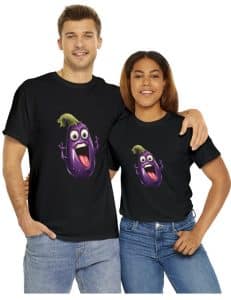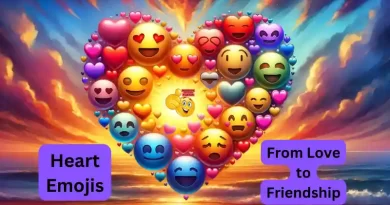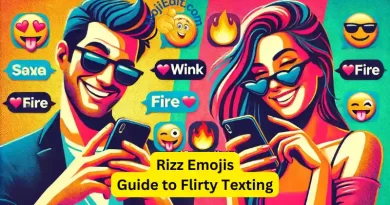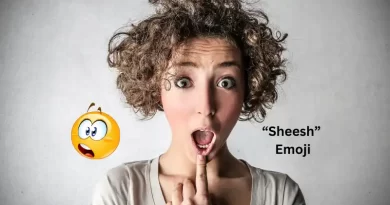Calm Emoji: Adding Peace to Your Digital Conversations
Have you ever scrolled through your emoji options and wondered about that serene-looking face with closed eyes and a slight smile? It’s the 😌 Relieved Face or the calm emoji, and it’s often used to express feelings of calm, tranquility, and relief. Whether you’ve just passed an exam or are simply enjoying a peaceful moment, the Relieved Face emoji perfectly captures those feelings in a tiny digital icon.
The concept of calm in emojis goes beyond just one face. Emojis can express a full range of emotions, and the Relieved Face is a key player in the emoji world. It shows not just relief but also a sense of quiet satisfaction and contentment. You might not realize it, but using this emoji can add a layer of emotion to your messages that words sometimes can’t fully capture.
In today’s fast-paced world, taking a moment to breathe and relax has become more important than ever. The 😌 Relieved Face emoji has become a digital symbol of those moments of peace we all crave. By including it in your messages, you can convey not just your feelings but also encourage a sense of calm and relaxation among your friends and family.
Key Takeaways
- The 😌 Relieved Face, aka the calm emoji, shows calm and peaceful feelings.
- Emojis can express a variety of emotions more effectively than words alone.
- Using emojis can add depth to digital communication.
The Concept of Calm in Emojis
When you think of calm emojis, you might imagine serene faces and peaceful symbols. These emojis help express feelings of tranquility and inner peace in our busy digital lives.
Understanding the Calm Emoji
Calm emojis, like the Relieved Face, are used to show contentment and relaxation. This soft, gentle emoji features closed eyes and a slight smile, perfect for when you want to convey a sense of peace or relief. Another example is the Lotus emoji, symbolizing purity and enlightenment, often associated with meditation and inner peace.
People also use scenarios to show calmness, like emojis of nature scenes, such as a person rowing a boat or a calm beach scene. These images help create a feeling of serenity and tranquility.
Some emojis are versatile and can signify multiple emotions. For instance, the Face in Clouds emoji can show calm, peace, or even daydreaming, depending on the context. Understanding these subtle differences can help you use the right emoji to express how you feel.
Tranquility and Peace of Mind
When talking about peaceful emojis, it’s hard to ignore the Relax emoji with its gentle smile and closed eyes. This emoji often suggests taking a break and finding some peace of mind. It’s ideal for those moments when you need to relax and let go of stress.
Nature-themed emojis also play a significant role in conveying tranquility. Imagine emojis like a calm-looking beach or a serene mountain. These symbols evoke a sense of quiet and peace, allowing you to escape mentally from the hustle and bustle.
Moreover, the emoji of a person meditating can help represent mindfulness and inner peace. It’s great for conversations about self-care or finding inner balance. All these symbols help us communicate calmness more visually and effectively in our digital conversations.
Relieved Face Emoji: A Closer Look
The 😌 Relieved Face emoji presents a sense of calm, peace, and relief. Below, I’ll explore how this emoji appears on different platforms and the importance of its sigh.
Emoji Design Across Platforms
The 😌 Relieved Face emoji looks slightly different depending on the platform you use. On Apple’s devices, the emoji has closed eyes and raised eyebrows, creating a serene look. Facebook takes it further by adding a slight open mouth, as if the face is sighing softly.
Microsoft’s version tends to be similar but simplifies the design, focusing on the calm expression through closed eyes and a gentle smile. Google’s take on the 😌 emoji also emphasizes the relaxed eyes and content smile, ensuring it universally conveys feelings of satisfaction and tranquility.
Each platform tweaks the details, but they all capture the core essence of relief and peace. These subtle design variations can slightly alter the emoji’s expression, making it important to know how 😌 appears on the device you’re using.
The Significance of a Sigh
A sigh often signifies a release of tension, and the 😌 Relieved Face emoji perfectly captures this action. Using 😌 can show you’re feeling relieved after a stressful event, like finishing a big exam or resolving a conflict.
When you send this emoji, it conveys a sense of gratitude, calm, and satisfaction. It tells the receiver that you’re at ease and things are finally okay.
In texting, sighs often follow situations that had potential stress or tension. For example, someone might text, “I got through the busy day at work! 😌”. This emoji adds depth, showcasing a genuine feeling of relief and contentment.
Understanding the context behind the sighing face helps you use the 😌 emoji more effectively. Whether it’s closing a chapter on a rough day or simply expressing peace, it’s a handy way to share feelings without words.
 Expressions of Calm and Contentment
Expressions of Calm and Contentment
Let’s explore how different aspects of the calm emoji convey feelings of tranquility and happiness. These are captured in visual communication through joy, gratitude, comfort, and satisfaction.
Joy and Gratitude
The calm emoji often comes with a serene smile 😌. This little symbol can express relief after overcoming a challenge. Think about finishing a tough exam or completing a project. It’s a way to show that feeling of accomplishment and appreciation for getting through it.
For example, when someone texts, “I aced my final exams 😌,” it shows their happiness and thankfulness for the success. It’s not just about being calm; it’s about feeling grateful for the positive outcome. When used in messages, this emoji tells others you’re in a good place mentally and emotionally.
Gratitude plays a big role here. You use it to say thanks in a mellow way. Maybe you’ve been stressed and someone helped you out. Sending them this emoji is a sweet, simple way to show your appreciation without needing many words.
Comfort and Satisfaction
Comfort and satisfaction are key feelings tied to this emoji. Picture sinking into a comfy chair after a long day or enjoying a peaceful moment with your favorite cup of tea. These moments of self-care and relaxation are perfect for the calm emoji.
For instance, texting, “Just had the best bubble bath ever 😌” captures that feeling of luxury and ease. It’s all about indulging in small comforts that make life enjoyable. This emoji represents those little moments when everything feels just right.
Using this emoji, you can also express contentment. It’s like saying, “I’m good, life is good,” without using words. It helps convey a sense of balance and well-being. Perfect for when things are going smoothly and you’re simply content.
Emoji Use in Digital Communication
Emojis have changed the way we talk online. They make messages fun, help express feelings, and even replace words in conversations. Here’s how they work as language tools and impact our digital interactions. 😊📱
Emojis as Linguistic Tools
Emojis are more than just cute pictures. They act like words or phrases, adding emotion and context to our messages. For instance, using a smiley face emoji 😀 can show happiness, while a thumbs up 👍 can show agreement. Emojis often replace text, like sending a 🥳 instead of typing out “Happy Birthday!”
Some emojis have broad meanings that can fit many situations. For example, the love emojis ❤️ can express love, support, or happiness. Also, there are kaomoji, which are Japanese-style text characters like (✿◠‿◠) that convey emotions too.
Emojipedia is a great resource to learn more about each emoji’s different meanings and uses. This site explains the subtle details behind each character, so you know what you’re really saying when you use them.
Impact on Online Interactions
Emojis have a huge impact on online chats. They help set the tone and clarify your message. Imagine texting “I’m fine” when you’re not. Adding a sad face 😢 changes the meaning completely. Emojis can also soften harsh messages, making communication smoother.
Different groups use emojis differently. Teenagers might use the latest trending emojis to stay cool, while older adults might stick to basics like 🙂 and 👍. Studies show that women use more emojis than men, often to convey empathy and warmth.
Relaxation themes are popular too. Emojis like 🌊, 🧘, and 🛀 help people talk about chilling out or relaxing. They give a quick visual cue that everyone instantly understands. This visual shorthand saves time and helps people connect emotionally, even in short texts.
Using emojis in digital chats bridges gaps and makes talking online more personal and expressive. So, whether you’re feeling happy, sad, or anything in between, there’s an emoji that fits! 🌟
Why Use Calm Emojis?
In our fast-paced digital world, emojis help express emotions and set the tone of a conversation. Calm emojis can:
- Reduce Stress: Seeing and using them can have a subtle, relaxing effect.
- Enhance Messages: They add a peaceful touch to texts, making conversations more pleasant.
- Express Emotions: Perfect for when you want to convey peace, relaxation, or a need for calm.
Other Popular Calm Emojis
- 😌 (Relieved Face): This emoji shows a calm and content expression, often used to indicate relief or relaxation.
- 🧘 (Person in Lotus Position): Represents meditation and mindfulness.
- 🌅 (Sunrise): Symbolizes the beauty and tranquility of a new day.
- 🕊️ (Dove Emoji): A universal symbol of peace and calm.
How to Use Calm Emojis
You can use calm emojis in various contexts:
- Social Media: Share your peaceful moments with friends.
- Text Messages: Add a calming touch to your conversations.
- Meditation Apps: Enhance your posts about mindfulness and relaxation.
For example:
- Texting a Friend: “Just finished a great yoga session 🌿✨”
- Social Media Post: “Taking a moment to relax and unwind 😌🧘”
Evolution of the Relieved Emoji
The relieved face emoji has transformed since its early days, reflecting technological advancements and user demands. It conveys calm, peace, and contentment, and has undergone significant updates in design and compatibility.
Unicode Incorporation
The relieved face emoji became part of Unicode 6.0 in 2010. Unicode allows emojis to be universally recognized, ensuring that people on different devices can see them. With this standardization, emojis became more accessible across platforms like iOS, Android, and Windows.
Shigetaka Kurita originally created emojis for a Japanese mobile platform in the late 90s. Unicode’s adoption allowed global users to express emotions like relief, making this emoji a staple. Regular updates ensure the emoji stays relevant and visually appealing.
Variations and Compatibility
Different platforms display the relieved face emoji in slightly varied ways. For example, Facebook’s version has a slightly open mouth, while other platforms keep the mouth closed. These differences can change the emoji’s perceived emotion subtly.
Compatibility remains crucial. Emojis need to appear correctly on all devices, so developers continually update to meet new standards. Android and Windows, for instance, frequently roll out updates, enhancing both appearance and usability. Embracing these variations ensures everyone can enjoy a consistent experience.
With platforms like Zedge, users often explore new emoji designs, keeping the emoji culture vibrant. Regular tweaks and updates across devices ensure the relieved face emoji continues to convey the right emotions, no matter where you are.
Emotional Themes and Emoji Combinations
Emojis are a fun way to show feelings and moods. Combining emojis can create specific and clear emotional messages, perfect for texting friends or posting on social media.
Conveying Mood
Using emojis, you can easily show how you feel. For example, the 😌 Relieved Face emoji shows peace and calm. Meanwhile, the 😊 Smiling Face with Smiling Eyes can express happiness and contentment.
For moments of love and affection, the ❤️ Red Heart and 😍 Heart Eyes emoji pair is super effective. On the other hand, the 😔 Pensive Face can display sadness, and the 😤 Face with Steam From Nose is great for showing frustration or anger.
Add holiday flair with 🎄 Christmas Tree or 🎃 Pumpkin emojis to show festive moods. When feeling like taking a break, the 🌴 Palm Tree or 🛌 Person in Bed emojis are perfect for conveying rest and relaxation.
Emoji Pairings and Context
Pairing emojis can make your message even clearer. For example, combining 😍 Heart Eyes and 💋 Kiss Mark shows deep love and affection. A fun combo like 🤪 Zany Face and 😂 Face With Tears of Joy can share a funny or silly moment.
When you need to express tiredness or the need to relax, pairing 😴 Sleeping Face with 🛌 Person in Bed is spot-on. For situations where you’re feeling grateful, you might use the 🙏 Folded Hands and 😊 Smiling Face With Smiling Eyes combo.
Themes such as nature or holidays can also influence your emoji choices. For example, combine 🏠 House and 🌳 Deciduous Tree to suggest a calm, homely feeling. Or, 🌟 Glowing Star and 🎇 Sparkler can enhance messages during New Year’s festivities.
Using specific emoji combinations makes your messages more vivid and meaningful. So next time you text, give these pairs a try!
Cultural Impact of Emojis
Emojis play a huge role in how we communicate online. They influence how we express feelings on social media and pop culture.
Influence on Social Media
Emojis make our online chats more colorful and expressive. I love seeing how they can change the tone of a tweet or Instagram comment. For example, adding a simple smiley face 😊 can make a message seem friendly and warm. This is especially true on platforms like Twitter and Instagram.
But it’s not just about making messages look pretty. Emojis can help cut through language barriers. This is super helpful on international platforms like Mastodon and TikTok. People can understand each other better even if they don’t speak the same language.
Also, emojis can affect our credibility. Studies show that using emojis in professional settings can make you seem more likable and trustworthy. And in fast-paced workplaces, a quick thumbs-up 👍 or a heart ❤️ can save time and clearly convey emotions.
Emojis in Pop Culture
Emojis are everywhere in pop culture. They show up in songs, movies, and even clothing designs. Back in 2017, there was even a whole movie called The Emoji Movie. It’s wild to think how these little icons have become such a big part of how we express ourselves.
Brands also love to use emojis in their marketing. Companies like Google and Microsoft often incorporate emojis to seem more relatable to younger audiences. They know emojis are a fun and engaging way to get people’s attention.
Additionally, pop culture celebrities often use emojis in their social media posts. Their fans love it because it feels more personal and engaging. Emojis can say so much with just one icon, making them a go-to tool for sharing emotions quickly and effectively.
Emojis and Branding
Emojis have become a key part of branding strategies. Companies use them to connect with customers and enhance their brand image. They also need to handle issues like trademark and copyright when using these little icons.
Corporate Use of Emojis
Brands use emojis to make their communications more friendly and relatable. For example, a relieved face emoji 😌 can convey ease or satisfaction, making the brand seem more approachable and human. Some companies, like NRS Plus, even use emojis in their point of sale systems to engage customers while they process transactions. Emojis can be included in social media posts, email marketing, and even on product packaging to catch the eye of consumers.
The money emoji 💵 is often used in marketing campaigns to highlight deals or savings, tying the brand to customer benefit. The playful nature of emojis helps reduce the corporate feel and add a personal touch.
Trademark and Copyright
Using emojis in branding comes with legal considerations. Major companies may incorporate emojis into their trademarks. For instance, Snapchat has trademarked exclusive emojis used on their platform. You need to check the terms of service for each emoji to avoid legal issues. Emojis can be subject to copyright laws, which means using them without permission might lead to complications.
Brands should ensure they don’t infringe on registered trademarks. For a smooth experience, companies should work directly with emoji creators or use emojis available under open licenses. This helps avoid any potential legal hiccups and ensures a seamless branding strategy.
By understanding these points, companies can effectively use emojis to boost their brand, while staying compliant with legal standards.
Conclusion: Embrace the Calm
In the whirlwind of our digital lives, finding moments of calm and tranquility is more important than ever. The 😌 Relieved Face emoji and other calm-related emojis provide a simple yet powerful way to express these peaceful feelings in our conversations. From showing gratitude and contentment to emphasizing relaxation and mindfulness, these little icons add depth and emotion to our messages that words alone sometimes can’t convey.
Using calm emojis in your digital interactions can not only help you communicate your feelings more effectively but also spread a sense of peace and relaxation to those around you. Whether you’re celebrating a personal victory, taking a moment to breathe, or encouraging a friend to find their inner calm, these emojis are the perfect companions.
So next time you’re texting, tweeting, or posting, don’t forget to sprinkle in some calm emojis. They might just bring a touch of serenity to your day and to the digital lives of those you connect with. 🌿✨
Remember to keep exploring the world of emojis and find new ways to express yourself. Happy texting!
Frequently Asked Questions
The calm emoji 🌿 is super versatile and can be used in many different ways. Here’s a quick guide on how to make the best use of it in your digital conversations.
The 😌 Relieved Face emoji typically conveys feelings of calm, peace, and relief. It can also express happiness or good-natured humor depending on the context
Use the 😌 calm emoji when you want to show that you feel relieved or at peace, such as after completing a stressful task or when enjoying a moment of tranquility
Yes, other emojis like the 🧘 (Person in Lotus Position) and 🌿 (Herb) also convey feelings of calmness and tranquility.
The 😌 Relieved Face emoji was approved as part of Unicode 6.0 in 2010 and added to Emoji 1.0 in 2015, reflecting its established role in digital. communication
Yes, the 😌 emoji can be used in professional communication to convey a sense of relief or satisfaction, but ensure the context is appropriate and the tone remains professional

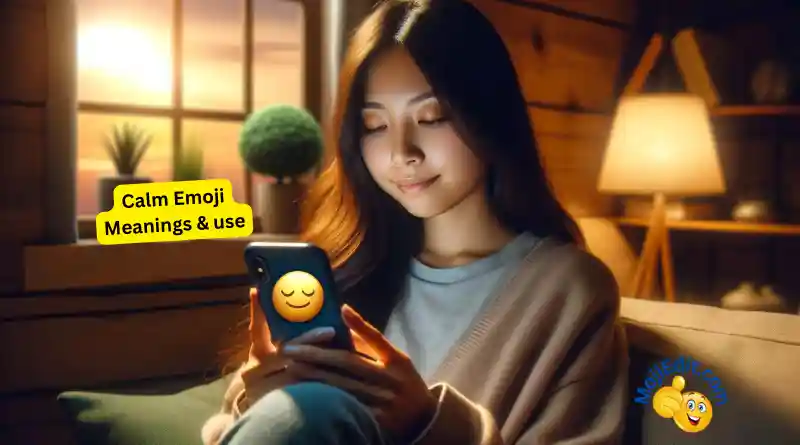
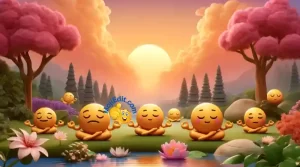 Expressions of Calm and Contentment
Expressions of Calm and Contentment
